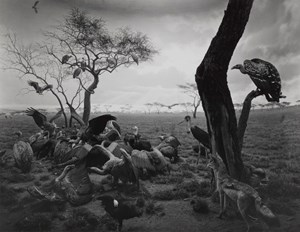
Renowned Japanese artist Hiroshi Sugimoto has brought his first exhibition, "Past and Present in three parts", to the Multimedia Art Museum in Moscow. Sugimoto's works are simple by their form, but complex in their content. For this show, the Museum’s exhibition hall was turned into a deliberately dark space, divided into three parts: the first part contains a series of theaters, the second - the sea, and the third presents dioramas.
Renowned Japanese artist Hiroshi Sugimoto has brought his first exhibition, "Past and Present in three parts", to the Multimedia Art Museum in Moscow. Sugimoto's works are simple by their form, but complex in their content. For this show, the Museum’s exhibition hall was turned into a deliberately dark space, divided into three parts: the first part contains a series of theaters, the second - the sea, and the third presents dioramas.
In “Dioramas”, Sugimoto offers a series of photographs taken in New York’s Museum of Natural History. Simply by photographing the exhibition’s dioramas, Sugimoto consciously created a project that balances fact and fiction. The fictitiousness of these dioramas is evident when examined visually, three-dimensionally. In Sugimoto’s photographic interpretation, however, these pieces are made to appear in such a realistic manner that their previously undeniable fakeness was transformed into fact by way of a two-dimensional image.
Now, a philosophical question arises: how true can photography be. With this question, we are being referred to the concept of the simulacrum, so popular in the mid 70’s when Sugimoto’s series was created. The notion of the simulacrum is based on fiction, on a copy that does not have an original. So, a diorama is a reproduction of a reality which never existed - however, it follows a scientifically influenced form of visual documentation, which gives the impression that the diorama presents an actual reality, in miniature scale. And, so, we come to a game of paradoxes, in which Sugimoto documented fictions through hyper-realistic pictures.
The artist’s choice of a black and white scale is also deliberate. The printing technique itself preserves the original appearance of these photographs for centuries, which makes them physically unresponsive to fading.
It is evident that this exhibition has been very clearly thought through, an impression that is achieved by the convenient spotlighting of each work, emphasizing each advantage. For example, in the series of dark theaters, the most excellent details are found in the shadows, where the tangible luminous flux emanating from the screens draws attention to the most beautiful forms of the architecture, the chairs and the decorations inside the space.

Hiroshi Sugimoto. Hyena-Jackal-Vulture. 1980. © Hiroshi Sugimoto. Courtesy of Gallery Koyanagi. Source: Multimedia Art Museum, Moscow
“Theatres” also contain its own ideological context. Bright light is the center of the composition, which is also the essence of the work. The screen incorporates the duration of the whole film, which needs 2 - 3 hours of exposure. Connections between the visual image of the theater’s interior and the idea of a time period - leading to an empty screen - shows a complex construction, on which this photographic work is based - a competent balance between two principles: form and content.

Hiroshi Sugimoto. Goshen, Indiana. 1980. © Hiroshi Sugimoto. Courtesy of Gallery Koyanagi. Source: Multimedia Art Museum, Moscow
“Seascapes” series presents one of Sugimoto’s quintessential searches: the ultimate balance and harmony of the two opposites: sky and water, a landscape devoid of subjective evaluations and attaining a formal perfection.

Hiroshi Sugimoto. Boden Sea, Uttwil. 1993. © Hiroshi Sugimoto. Courtesy of Gallery Koyanagi. Source: Multimedia Art Museum, Moscow
Much has been said about Sugimoto’s work, so it’s almost impossible to say something new. However, in summing up, it should be noted that Sugimoto provided a new impetus to creative visual imagery in American art, one where the work is based on balance between the external and the internal. Such a unique approach puts Sugimoto among the most interesting artists of our time.
Written by Dimitri Bogachuk, http://dimitribogachuk.com/

ArtDependence Magazine is an international magazine covering all spheres of contemporary art, as well as modern and classical art.
ArtDependence features the latest art news, highlighting interviews with today’s most influential artists, galleries, curators, collectors, fair directors and individuals at the axis of the arts.
The magazine also covers series of articles and reviews on critical art events, new publications and other foremost happenings in the art world.
If you would like to submit events or editorial content to ArtDependence Magazine, please feel free to reach the magazine via the contact page.